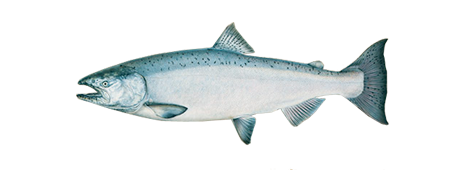King Salmon

The King Salmon is an extremely important food and commercial fish, and due to its large size and game nature, an important sport fish.
HOW TO IDENTIFY A KING SALMON
Its body is typical of the Pacific salmon group (see Salmons, Trouts, and Chars). At sea, it is basically a silvery fish with spotting on the back, upper sides, top of head, and all the fins, including the tail fin. Spawning chinooks are olive brown to purplish or even red and undergo a radical metamorphosis, especially the males which develop a large kype. One way to distinguish the chinook from other species is by its black mouth and gums. The similar looking coho Oncorhynchus kisutch, has a black mouth, but white gums, except in the Great Lakes population where the gums may be gray or black.
WHERE TO CATCH KING SALMON
It is a member of the Pacific salmon genus Oncorhynchus and is both largest and least abundant of this group. It is endemic to the Pacific and rarely, the Arctic Ocean as well as the Bering Sea, the Okhotsk Sea, the Sea of Japan, and most of the rivers that flow into these waters; from Hokkaido in northern Japan to the Anadyr River in the former U.S.S.R., and from the Ventura River in southern California to Point Hope, Alaska. Since as early as 1872, it has been introduced into other waters around the world including the Great Lakes, Atlantic and Gulf states of the U.S., some areas of Central and South America, Europe, and the South Pacific. These transplanted populations apparently failed due to an inability to maintain spawning levels, with the exceptions of South Island in New Zealand, and to some degree in the Great Lakes. In Chile, more recent transplants have shown hope of becoming established with some chinook returning to spawn. The following list includes additional details on where to catch this fish:
BACKFLOW BAYS AND ESTUARIES
OVERHANGING TREES AND BUSHES MAN-MADE STRUCTURES
RIVERS AND STREAMS SCHOOLS
DROP-OFFS MERGING CURRENTS
STANDING WAVES CURRENT EDGES
BAYS CHANNEL ENTRANCES
RIPPLES, CURRENTS, SWIRLS AND SPRAYS OUTSIDES OF BENDS
ROCK AND BOULDER POCKETS DAMS AND FALLS
EDDIES SMALL POINTED WAVES
UNDERCUTS
HOW TO CATCH KING SALMON
The following are fishing methods used to catch this fish:
JIGGING FLY FISHING
STILL FISHING DRIFT FISHING
TROLLING
KING SALMON LURES, TACKLE & BAIT
The following are lures, tackle or bait that can be used to catch this fish:
CUT BAIT PLUGS
SPOONS FRESHWATER LIVE BAIT
SPINNER BAITS